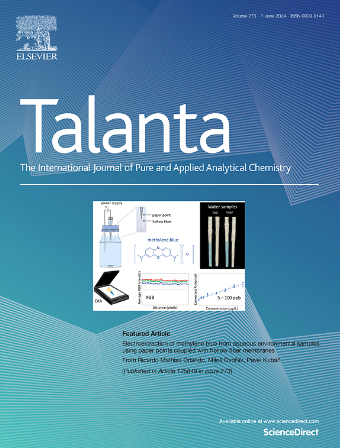The rational design of europium complex based electrochemiluminescence sensor for highly efficient carbaryl detection
IF 5.6
1区 化学
Q1 CHEMISTRY, ANALYTICAL
引用次数: 0
Abstract
To address the issue that most of the reported electrochemiluminescence (ECL) sensors are usually subjected to various complicated chemical modifications, we proposed a sensitive ECL sensor by using a neutral mononuclear lanthanide metal europium complex Eu(L)3 (L = 2-pyrazol-1-yl-6-(1H-tetrazol-5-yl)-pyridine) as luminophore with simple chemical composition for the accurate detection of carbaryl pesticide residues. The three conjugated tridentate pyrazo-pyridine- tetrazol ligands could put significant effect on the physical and chemical behavior of the central Eu3+ ion, leading to the excellent luminescent performance of the Eu(L)3 complex enhanced by “antenna effect” of the auxiliary anionic organic ligands. The naphthol obtained from the hydrolysis reaction of carbaryl in an alkaline working solution could effectively and quantitatively quench the luminescence intensity of the Eu(L)3 complex, which has been theoretically confirmed by the detailed density functional theory (DFT) and time-dependent DFT (TDDFT) calculations, thus obviously strengthening the target detection capability on carbaryl. Based-on such the idea, the skillfully constructed ECL sensor showed superior carbaryl detection performance with good linearity in the range of 1 pg/mL to 1000 ng/mL, and a satisfied detection limit of 8.8 pg/mL (S/N = 3) under the optimized conditions. The current simple ECL carbaryl detection platform exhibited the conspicuous superiority to those existed commercial ones and thus, more importantly, provided a very promising practical value in the field of environmental detection (oil, soil, water, etc.) of organic phenol pollutants.

求助全文
约1分钟内获得全文
求助全文
来源期刊

Talanta
化学-分析化学
CiteScore
12.30
自引率
4.90%
发文量
861
审稿时长
29 days
期刊介绍:
Talanta provides a forum for the publication of original research papers, short communications, and critical reviews in all branches of pure and applied analytical chemistry. Papers are evaluated based on established guidelines, including the fundamental nature of the study, scientific novelty, substantial improvement or advantage over existing technology or methods, and demonstrated analytical applicability. Original research papers on fundamental studies, and on novel sensor and instrumentation developments, are encouraged. Novel or improved applications in areas such as clinical and biological chemistry, environmental analysis, geochemistry, materials science and engineering, and analytical platforms for omics development are welcome.
Analytical performance of methods should be determined, including interference and matrix effects, and methods should be validated by comparison with a standard method, or analysis of a certified reference material. Simple spiking recoveries may not be sufficient. The developed method should especially comprise information on selectivity, sensitivity, detection limits, accuracy, and reliability. However, applying official validation or robustness studies to a routine method or technique does not necessarily constitute novelty. Proper statistical treatment of the data should be provided. Relevant literature should be cited, including related publications by the authors, and authors should discuss how their proposed methodology compares with previously reported methods.
 求助内容:
求助内容: 应助结果提醒方式:
应助结果提醒方式:


